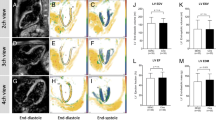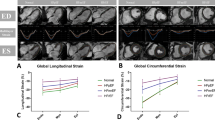Abstract
Purpose
Cardiac strain calculated from tagged magnetic resonance (MR) images provides clinicians information about abnormalities of heart-wall motion in patients. It is important to develop an accurate method to determine the cardiac strain efficiently. An adaptive windowed harmonic phase (AWHARP) method is proposed for cardiac strain calculation.
Materials and methods
AWHARP is based on adaptive windowed Fourier transform (AWFT) and 2D Gabor wavelet transform (2D-GWT). The AWFT provides a spatially varying representation of the signal spectra, which allows the harmonic phase (HARP) image to be extracted with high accuracy. Instantaneous spatial frequencies are calculated using 2D-GWT, and the widths of the adaptive windows are then determined according to the instantaneous spatial frequencies for multi-resolution analysis of phase extraction. The proposed method was studied using simulated images and patients’ MR images. Both single tagged images (SPAMM) and subtracted tagged images (CSPAMM) were generated using our simulation method, and their results calculated using AWHARP and HARP methods were compared. Normal and pathological tagged MR images were also processed to evaluate the performance of our method.
Results
Our experimental results show that the accuracies of phase and strain images calculated using the AWHARP method are higher than that calculated using the HARP method especially for large tag line deformation. The improvement in accuracies can be up to 3.2 strain (E1) and 17.3 calculation from MR images reveals that the cardiac strain in the end-systolic state is significantly reduced for patients with hypertrophic cardiomyopathy (HCM) compared to that of healthy subjects.
Conclusion
The proposed AWHARP is an accurate and efficient method for cardiac strain estimation from MR images. This new algorithm can help clinicians to detect left ventricle dysfunctions and myocardial diseases with accurate cardiac strain analysis.
Similar content being viewed by others
Abbreviations
- 2D-GWT:
-
2D Gabor wavelet transform
- AWFT:
-
Adaptive windowed Fourier transform
- AWHARP:
-
Adaptive windowed harmonic phase
- CSPAMM:
-
Complementary spatial modulated magnetization
- HARP:
-
Harmonic phase
- SPAMM:
-
Spatial modulated magnetization
- LV:
-
Left ventricle
- HCM:
-
Hypertrophic cardiomyopathy
References
Atalar E, McVeigh E (1994) Optimization of tag thickness for measuring position with magnetic resonance imaging. IEEE Trans Med Imaging 13(1): 152–160
Guttman MA, Prince JL, McVeigh ER (1994) Tag and contour detection in tagged MR images of the left ventricle. IEEE Trans Med Imaging 13(1): 74–88
Kerwin WS, Prince JL (1999) Tracking MR tag surfaces using a spatiotemporal filter and interpolator. Int J Imaging Syst Technol 10(2): 128–142
Deng X, Thomas SD (2005) Combined tag tracking and strain reconstruction from tagged cardiac MR images without user-defined myocardial contours. J Magn Reson Imaging 21(1): 12–22
Kumar S, Goldgof D (1993) Automatic tracking of SPAMM grid and the estimation of deformation parameters from cardiac MR images. IEEE Trans Med Imaging 13(1): 122–132
Amini AA, Chen Y, Curwen RW, Mani V, Sun J (1998) Coupled B-snake grids and constrained thin-plate splines for analysis of 2-D tissue deformations from tagged MRI. IEEE Trans Med Imaging 17(3): 344–356
Clarysse P, Basset C, Khouas L, Croisille P, Friboulet D, Odet C, Magnin IE (2000) Two-dimensional spatial and temporal displacement and deformation field fitting from cardiac magnetic resonance tagging. Med Image Anal 4(3): 253–268
Qian Z, Huang X, Metaxas D, Axel L (2005) Robust segmentation of 4D cardiac MRI-tagged images via spatio-temporal propagation. In: Proceedings of the SPIE Medical Imaging, vol 5746, pp 580–591 (2000)
Rougon N, Petitjean C, Preteux F, Cluzel P, Grenier P (2005) A non-rigid registration approach for quantifying myocardial contraction in tagged MRI using generalized information measures. Med Image Anal 9(4): 353–375
Prince JL, McVeigh ER (1992) Motion estimation from tagged MR image sequences. IEEE Trans Med Imaging 11(2): 238–249
Denney JT, Prince JL (1994) Optimal brightness functions for optical flow estimation of deformable motion. IEEE Trans Image Proc 3(2): 178–191
Gupta SN, Prince JL (1995) On variable brightness optical flow for tagged MRI. Inf Process Med Imaging 323(334): 323–334
Haber I, Kikinis R, Westin CF (2001) Phase-driven finite element model for spatio-temporal tracking in tagged cardiac MRI. In: Proceedings of the MICCAI, pp 1332–1335
Osman NF, Kerwin WS, McVeigh ER, Prince JL (1999) Cardiac motion tracking using cine harmonic phase (harp) magnetic resonance imaging. Magn Reson Med 42(6): 1048–1060
Osman NF, McVeigh ER, Prince JL (2000) Imaging heart motion using harmonic phase MRI. IEEE Trans Med Imaging 19(3): 186–202
Osman NF, Prince JL (2000) Visualizing myocardial function using HARP MRI. Phys Med Biol 45(6): 1665–1682
Liu W, Chen JJ, Ji SB, Allen SJ, Bayly PV, Wickline SA, Yu X (2004) Harmonic phase MR tagging for direct quantification of Lagrangian strain in rat hearts after myocardial infarction. Magn Reson Med 52(6): 1282–1290
Pan L, Prince JL, Lima JA, Osman NF (2005) Fast tracking of cardiac motion using 3D-HARP. IEEE Trans Biomed Eng 52(8): 1425–1435
Venkatesh BA, Gupta H, Lloyd SG, Italia LD, Denney TS (2010) 3D left ventricular strain from unwrapped harmonic phase measurements. J Magn Reson Imaging 31(4): 854–862
Arts T, Prinzen FW, Delhaas T, Milles JR, Rossi AC, Clarysse P (2010) Mapping displacement and deformation of the heart with local sine-wave modeling. IEEE Trans Med Imaging 29(5): 1114–1123
Chen T, Wang XX, Chung S, Metaxas D, Axel L (2010) Automated 3D motion tracking using gabor filter bank, robust point matching and deformable models. IEEE Trans Med Imaging 29(1): 1–11
Wang H, Amini AA (2010) Accurate 2-D cardiac motion tracking using scattered data fitting incorporating phase information from MRI. In: Proceedings of the SPIE Medical Imaging, vol 7626, pp 520–523
Osman NF, Prince JL (2000) On the design of the bandpass filters in harmonic phase MRI. Int Conf Image Process 1: 625–628
Barajas J, Barnes JG, Carreras F, Pujadas S, Radeva P (2005) Angle images using gabor filters in cardiac tagged MRI. In: Proceedings of the conference AI R&D, pp 560–566
Marinelli M, Positano V, Osman NF, Recchia FA, Lombardi M, Landini L (2008) Automatic filter design in HARP analysis of tagged magnetic resonance images. Biomedical Imaging: From Nano to Macro, 2008. ISBI 2008. 5th IEEE International Symposium, 14–17 May 2008
Cordero-Grande L, Vegas-Sanchez-Ferrero G, Casaseca-de-la-Higuera P, Alberola-Lopez C (2011) Improving harmonic phase imaging by the windowed fourier transform. Biomedical Imaging: From Nano to Macro, 2011 IEEE International Symposium, 30 Mar–2 Apr 2011
Weng J, Zhong J, Hu C (2009) Phase reconstruction of digital holography with the peak of the two-dimensional Gabor wavelet transform. Appl Opt 48(18): 3308–3316
Zhong JG, Zeng HP (2007) Multiscale windowed fourier transform for phase extraction of fringe patterns. Appl Opt 46(14): 2670–2675
Kuijer JP, Jansen E, Marcus JT, Rossum AC, Heethaar RM (2001) Improved harmonic phase myocardial strain maps. Magn Reson Med 46(5): 993–999
Douglas AS, Hunter WC, Wiseman MD (1990) Inhomogeneous deformation as a source of error in strain measurements derived from implanted markers in the canine left ventricle. J Biomech 23(4): 331–341
Fu YB, Chui CK, Teo CL, Kobayashi E (2011) Motion tracking and strain map computation for quasi-static magnetic resonance elastography. MICCAI LNCS 6891: 433–440
Fischer SE, McKinnon GC, Maier SE, Boesiger P (1993) Improved myocardial tagging contrast. Magn Reson Med 30(2): 191–200
Aletras AH, Freidlin RZ, Navon G, Arai AE (2004) AIR-SPAMM: alternative inversion recovery spatial modulation of magnetization for myocardial tagging. J Magn Reson 166(2): 236–245
Ennis DB, Epstein FH, Kellman P, Fananapazir L, Mcveigh ER, Arai AE (2003) Assessment of regional systolic and diastolic dysfunction in familial hypertrophic Cardiomyopathy using MR tagging. Magn Reson Med 50(3): 638–642
Young AA, Kraitchman DL, Axel L (1994) Deformable models for tagged MR images: reconstruction of two and three dimensional heart wall motion. Proc IEEE Workshop Biomed Image Anal 19: 317–323
Author information
Authors and Affiliations
Corresponding author
Rights and permissions
About this article
Cite this article
Fu, Y.B., Chui, C.K. & Teo, C.L. Accurate two-dimensional cardiac strain calculation using adaptive windowed Fourier transform and Gabor wavelet transform. Int J CARS 8, 135–144 (2013). https://doi.org/10.1007/s11548-012-0689-2
Received:
Accepted:
Published:
Issue Date:
DOI: https://doi.org/10.1007/s11548-012-0689-2




